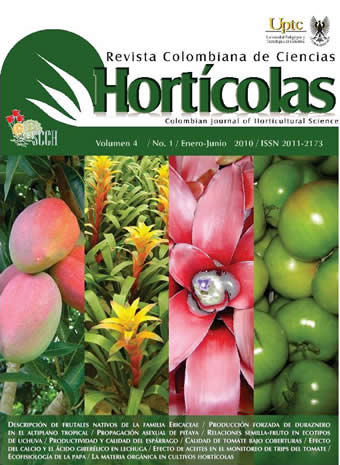Efecto de aceites esenciales naturales en el monitoreo de trips del tomate (Frankliniella schultzei Trybom) en Gerbera jamesonii (H. Bolus) (Asteraceae)

Resumen
El trips Frankliniella schultzei Trybom (Thysanoptera: Thripidae) es una especie polífaga que se alimenta de varias especies ornamentales y hortícolas, y puede causar daños directos e indirectos en cultivos, tanto adultos como ninfas se alimentan de polen y tejido floral. El estudio que se reporta en este artículo se llevó a cabo con el objetivo de evaluar el efecto atractivo de aceites esenciales naturales de canela y romero colocados sobre trampas adhesivas de color rojo, empleadas para el monitoreo de trips en gérbera. Se demostró que el promedio de trips adultos capturados fue mayor en las trampas con aceite esencial natural de canela (AC1), seguido por las de aceite esencial natural de romero (AC2) y, por último, el control (sin aceite esencial natural). Estos resultados mostraron que los aceites esenciales naturales colocados en las trampas aumentaron significativamente la captura de trips en trampas adhesivas, en comparación con el control (sin aceite esencial natural).Palabras clave adicionales: canela, trampas adhesivas rojas, trips, romero, ornamental.
Citas
- Baranowski, T. y R. Górski. 1991. Przydatnooeæ kolorowych tablic w ochronie rooelin szklarniowych przed zkodnikami. pp. 39-43. En: Materia³ y XXXI Sesji Naukowej IOR. Cz. 2, Postery.
- Brodsgaard, H.E. 1989. Coloured sticky traps for Frankliniella occidentalis (Pergande) (Thysanoptera: Thripidae) in glasshouses. J. Appl. Entomol. 197, 136-140.
- Brodsgaard, J.F. 1990. The effect of anisaldehyde as a scent attractant for Frankliniella occidentalis (Thysanoptera: Thripidae) and the response mechanism involved. SROP/WPRS Bull. 13(5), 36-38.
- Cabello, T.; M.M. Abad y F. Pascual. 1991. Catches of F. occidentalis in traps of distinct colour in protected crops. Boletín de Sanidad Vegetal - Plagas 17, 265-270.
- Frey, J.E.; R.V. Cortada y H. Helbing. 1994. The potential of flower odours for use in population monitoring of western flower thrips Frankliniella occidentalis Perg. (Thysanoptera: Thripidae). Biocontr. Sci. Technol. 4(2), 177-186.
- Floris, I.; C. Carta y M.D. Moretti. 1996. Activites in vitro de plusieurs huiles essentielles sur Bacillus larvae White et essai au rucher. Apidologie 27(2), 111-119.
- Gillespie, D.R. y R.S. Vernon.1990. Trap catch of western flower thrips (Thysanoptera: Thripidae) as affected by color and height of sticky traps in mature greenhouse cucumber crops. J. Econ. Entomol. 83, 971-975.
- Górski, R. 1999. Monitorowanie szkodników rooelin szklarniowych. Progr. Plant Prot./ Post.Ochr. Rooel. 39(1) 321-325.
- Górski, R. 2001. Barwne pu³apki chwytne w monitorowaniu szkodników rooelin szklarniowych. Rocz. AR Pozn. Rozpr. Nauk. 310, 3-108.
- Higgins, C.J. 1992. Western flower thrips in greenhouse populations dynamics, distribution on plants, and association with predators. J. Econ. Entomol. 85,1891-1903.
- Higgins, C.J. y J.H. Myers.1992. Sex ratio and population dynamics of western flower thrips (Thysanoptera: Thripidae). Environ. Entomol. 21, 322-330.
- Heinz, K.M.; M.P. Parella y J.P. Newman. 1992. Time efficient use of yellow sticky traps in monitoring insect populations. J. Econ. Entomol. 85, 2263-2269.
- Johansen, R.M. 2002. The Mexican Frankliniella fusca (Hinds), F. pallid (Uzel) and F. schultzei (Trybom) species assemblages, in the ‘intonsa group’ (Insecta, Thysanoptera: Thripidae). Acta Zool. Mex. 85, 51-82.
- Milne, J.R.; M. Jhumlekhasing y G.H. Walter. 1996. Understanding host plant relationships of polyphagous flower thrips, a case study of Frankliniella schultzei (Trybom). 8-14. En: Goodwin S. y P. Gillespie. (eds). Proc. 1995 Australia and New Zealand Thrips Workshop: Methods, Biology, Ecology and Management, NSW Agriculture. Gosford, Australia.
- Ozcan, M.M. y J.C. Chalchat. 2008. Chemical composition and antifungal activity of rosemary (Rosmarinus officinalis L.) oil from Turkey. Int. J. Food Sci. Nutr. 59(7-8), 691-698.
- Shipp, J.L. y N. Zariffa. 1991. Spatial patterns of and sampling methods for western flower thrips (Thysanoptera: Thripidae) on greenhouse sweet pepper. Can. Entomol. 123, 989-1000.
- Steiner, M.Y. 1990. Determining population characteristics and sampling procedures for the western flower thrips (Thysanoptera: Thripidae) and the predatory mite Amblyseius cucumeris (Acari: Phytoseiidae) on greenhouse cucumber. Environ. Entomol. 19, 1605-1613.
- Teulon, D.A.J. y P.M.J. Ramakers. 1990. A review of attractants for trapping thrips with particular reference to glasshouses. IOBC/WPRS Bull. 13, 212-214.
- Teulon, D.A.J.; D.R. Penman y P.M.J. Ramakers. 1993. Volatile chemicals for thrips (Thysanoptera: Thripidae) host finding and applications for thrips pest management. J. Econ. Entomol. 86,1405-1415.
- Vernon, R.S. y D.R. Gillespie. 1990. Spectral responsiveness of Frankliniella occidentalis (Thysanoptera: Thripidae) determined by trap catches in greenhouse. Environ. Entomol. 19, 1229-1241.
- Vernon, R.S. y D.R. Gillespie. 1995. Influence of trap shape, and background color on captures of Frankliniella occidentalis (Thysanoptera: Thripidae) in a cucumber greenhouse. J. Econ. Entomol. 88, 288-293.
- Yakua, A.; G.H. Walter y A.J. Najar – Rodriguez. 2007. Thrips see red – flower colour and the host relationships of a polyphagous anthophilic thrips. Ecol. Entomol. 32(5), 527–535.
- Yudin, L.S.; W.G. Mitchell y J.J. Cho. 1987. Color preference of thrips (Thysanoptera: Thripidae) with reference to aphids (Homoptera: Aphididae) and leafminer in Hawaiian lettuce farms. J. Econ. Entomol. 80, 51-55.
Descargas
Los datos de descargas todavía no están disponibles.